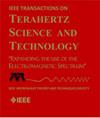Design and Measurements of a 480 GHz Metamaterial Flat Lens
IF 3.9
2区 工程技术
Q2 ENGINEERING, ELECTRICAL & ELECTRONIC
IEEE Transactions on Terahertz Science and Technology
Pub Date : 2024-11-07
DOI:10.1109/TTHZ.2024.3492996
引用次数: 0
Abstract
There exist scientifically interesting molecular lines, such as the ground state transitions of water, that cannot be observed except from space. Observations of these lines can be made more cost-effective by lightweighting observation components, such as the primary optical aperture. This is particularly important for SmallSats and CubeSats which have highly limited weight budgets. Here, we present a flat lightweight metamaterial lens, which operates at 480 GHz, close to the 557 GHz ground state transition of ortho–H480 GHz超材料平面透镜的设计与测量
存在着科学上有趣的分子线,例如水的基态转变,除非从太空中观察,否则无法观察到。通过轻量化观测组件,例如主光学孔径,可以使这些线的观测更具成本效益。这对于重量预算非常有限的小型卫星和立方体卫星来说尤其重要。在这里,我们提出了一个扁平的轻质超材料透镜,其工作在480 GHz,接近557 GHz的基态跃迁的正交h $_{2}$O。透镜由旋转涂层聚酰亚胺和图案铝交替层组成。通过对特定相图的优化,生成了铝的图形。我们已经制造并测试了镜头。镜头的光学直径为124mm。它重3克,厚度不到150微米。它也很灵活。我们已经证明,使用近场扫描,光学性能的镜头是几乎衍射有限。我们使用辐射测量技术发现透镜的损耗为2.5 dB。这个损失大约比预期高1.5 dB,我们调查了这种差异的可能原因。
本文章由计算机程序翻译,如有差异,请以英文原文为准。
求助全文
约1分钟内获得全文
求助全文
来源期刊

IEEE Transactions on Terahertz Science and Technology
ENGINEERING, ELECTRICAL & ELECTRONIC-OPTICS
CiteScore
7.10
自引率
9.40%
发文量
102
期刊介绍:
IEEE Transactions on Terahertz Science and Technology focuses on original research on Terahertz theory, techniques, and applications as they relate to components, devices, circuits, and systems involving the generation, transmission, and detection of Terahertz waves.
 求助内容:
求助内容: 应助结果提醒方式:
应助结果提醒方式:


